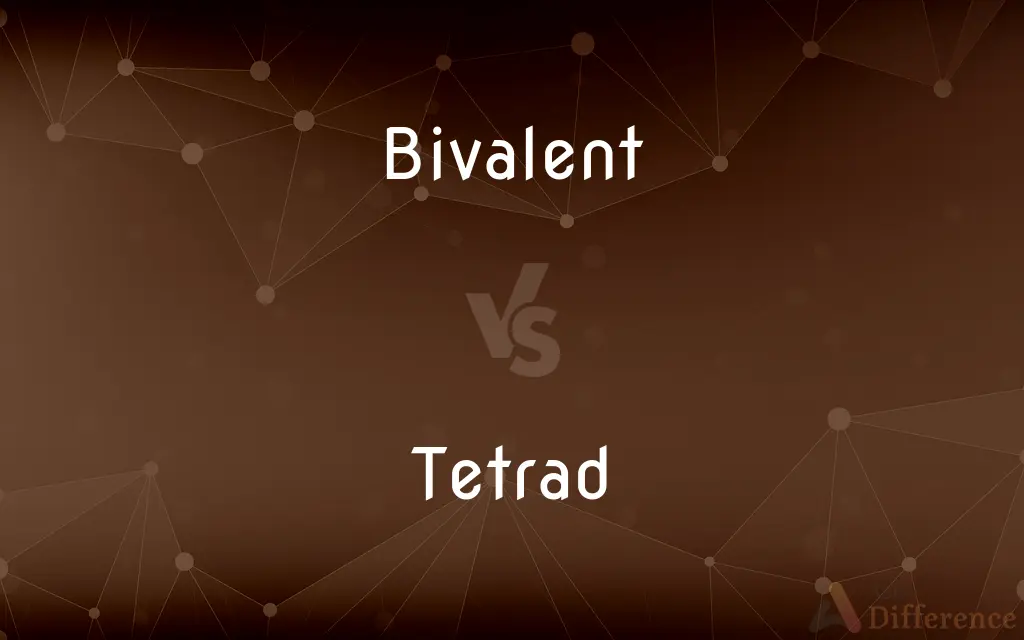Bivalent vs. Tetrad — What's the Difference?
Edited by Tayyaba Rehman — By Fiza Rafique — Updated on October 11, 2023
Bivalent consists of two homologous chromosomes paired together, while Tetrad is composed of four chromatids (two homologous chromosomes, each with two sister chromatids).

Difference Between Bivalent and Tetrad
Table of Contents
ADVERTISEMENT
Key Differences
Bivalent and Tetrad are terms used in the realm of genetics and cytology to describe structures seen during meiosis. A Bivalent consists of two homologous chromosomes that have paired up during meiosis I. These chromosomes come close together to exchange genetic material in a process called crossing over. On the other hand, a Tetrad, which is closely related to the concept of a bivalent, comprises four chromatids. These chromatids belong to the two homologous chromosomes in a bivalent. Thus, while a bivalent can be visualized as two chromosomes close together, a tetrad is the more intricate structure made up of these two chromosomes and their chromatids.
Both Bivalent and Tetrad play critical roles during the process of meiosis. Meiosis is essential for the formation of gametes in sexually reproducing organisms. During this process, homologous chromosomes come together to form a Bivalent. As they become intimately associated, the four chromatids of the two chromosomes can be viewed, forming the Tetrad.
Crossing over, or the exchange of genetic material between chromatids, occurs within the Tetrad. This process leads to genetic diversity among offspring. While the Bivalent is the broader structure showing chromosome pairing, the Tetrad gives a detailed view, highlighting the individual chromatids involved in the crossing over.
In summary, while both Bivalent and Tetrad are related to chromosome behavior during meiosis, they depict different structural levels. A Bivalent showcases the pairing of homologous chromosomes, whereas a Tetrad gives a detailed view of the four chromatids of those paired chromosomes.
Comparison Chart
Basic Structure
Two homologous chromosomes paired together.
Four chromatids from two paired homologous chromosomes.
ADVERTISEMENT
Number of Chromatids
Two chromatids (one from each chromosome).
Four chromatids (two from each chromosome).
Role in Genetic Variation
Forms the basis for chromosome pairing.
Allows crossing over between chromatids.
Seen During
Prophase I of meiosis.
Prophase I of meiosis.
Result of
Synapsis (pairing of homologous chromosomes).
Synapsis and subsequent cohesion.
Compare with Definitions
Bivalent
Representing two chromosomal structures in close association.
During meiosis, one can observe the bivalent nature of the paired chromosomes.
Tetrad
A group of four chromatids formed from each of a pair of homologous chromosomes.
The tetrad structure is essential for genetic recombination during meiosis.
Bivalent
A pair of homologous chromosomes during meiosis.
The cell displayed bivalents during prophase I of meiosis.
Tetrad
A set or group of four.
The puzzle consisted of various tetrads of colored tiles.
Bivalent
A molecule with two binding sites.
The antibody is bivalent, binding to two distinct sites on the antigen.
Tetrad
Four sporangia or spore-producing structures in fungi and plants.
The fern had distinct tetrads visible under the microscope.
Bivalent
Having two different values or qualities.
The symbol had a bivalent meaning in the context.
Tetrad
A configuration of four cells, as in certain bacterial division processes.
The bacterium divided to produce a tetrad of daughter cells.
Bivalent
(Genetics) Relating to or being a pair of homologous, side-by-side chromosomes, especially during meiosis; double.
Tetrad
The number four or a representation of it.
The symbol was a representation of the ancient tetrad.
Bivalent
Chemistry & Immunology Divalent.
Tetrad
A group or set of four.
Bivalent
(chemistry) Having a valence of 2; having two ligands
Tetrad
A tetravalent atom, radical, or element.
Bivalent
(genetics) Of, or relating to a pair of homologous synapsed chromosomes that occur during meiosis.
Tetrad
A four-part structure that forms during the prophase of meiosis and consists of two homologous chromosomes, each composed of two sister chromatids.
Bivalent
(of a vaccine) Protecting against two different viruses.
Tetrad
A group of four haploid cells, such as spores, formed by meiotic division of one mother cell.
Bivalent
(genetics) Any bivalent chromosome.
Tetrad
A group of four things.
Bivalent
Equivalent in combining or displacing power to two atoms of hydrogen; dyad.
Tetrad
(biology) Two pairs of sister chromatids (a dyad pair) aligned in a certain way and often on the equatorial plane during the meiosis process.
Bivalent
Having a valence of two or having two valences
Tetrad
(biology) A group of four haploid and immature pollen grains in tetrahedral fashion produced by meiotic microsporogenesis.
Bivalent
Used of a chromosome that is not paired or united with its homologous chromosome during synapsis;
A univalent chromosome
Tetrad
(cartography) A unit of land area of two by two (that is, four) square kilometres.
Bivalent
Exhibiting double valence.
The atom acted as a bivalent element in the reaction.
Tetrad
(chemistry) A tetravalent atom or radical.
Tetrad
(mathematics) A group of four basis vectors for a four-dimensional manifold in differential geometry.
Tetrad
The number four; a collection of four things; a quaternion.
Tetrad
A tetravalent or quadrivalent atom or radical; as, carbon is a tetrad.
Tetrad
The cardinal number that is the sum of three and one
Common Curiosities
What does Bivalent represent in genetics?
Bivalent represents a pair of homologous chromosomes paired together during meiosis.
How many chromatids does a Tetrad contain?
A Tetrad contains four chromatids from two paired homologous chromosomes.
What is the significance of a Tetrad in genetic recombination?
Tetrads allow for the crossing over or exchange of genetic material between chromatids, leading to genetic diversity.
In which phase of meiosis can Bivalent and Tetrad structures be observed?
Both Bivalent and Tetrad structures can be observed during the prophase I of meiosis.
Share Your Discovery

Previous Comparison
Software vs. Application
Next Comparison
Investment vs. SpeculationAuthor Spotlight
Written by
Fiza RafiqueFiza Rafique is a skilled content writer at AskDifference.com, where she meticulously refines and enhances written pieces. Drawing from her vast editorial expertise, Fiza ensures clarity, accuracy, and precision in every article. Passionate about language, she continually seeks to elevate the quality of content for readers worldwide.
Edited by
Tayyaba RehmanTayyaba Rehman is a distinguished writer, currently serving as a primary contributor to askdifference.com. As a researcher in semantics and etymology, Tayyaba's passion for the complexity of languages and their distinctions has found a perfect home on the platform. Tayyaba delves into the intricacies of language, distinguishing between commonly confused words and phrases, thereby providing clarity for readers worldwide.














































